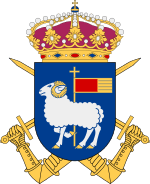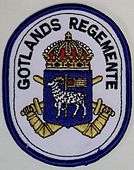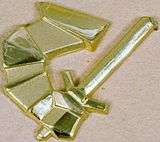Gotland Regiment
| Gotland Regiment | |
|---|---|
| Gotlands regemente | |
 | |
| Active | 1963–1994, 2000–2005 |
| Country |
|
| Allegiance | Swedish Armed Forces (1963–1994, 2000–2005) |
| Branch | Swedish Army |
| Type | Armoured regiment |
| Role | Mechanized infantry |
| Size | Regiment |
| Part of |
Milo Ö (1963–1982) MKG (1982–1994) Opil (2000–2005) |
| Garrison/HQ | Visborgsslätt |
| Motto(s) | Regementet för framtiden |
| Colors | Blue and white |
| March | "In Treue Fest" (Teike)[not 1] |
| Mascot(s) | Harald the Ram[2] |
| Disbanded | 2005 |
The Gotland Regiment (Swedish: Gotlands regemente), also P 18, was a Swedish Army armoured regiment that was active in various forms 1963–1994 and 2000–2005. The regiment was based in Visby as part of the Gotland Garrison.[3][4][5]
History

In connection with the 1958 Defense Decision, the Riksdag decided that eight armored brigades with new combat vehicles would be organized in the army. A decision which was for economic reasons changed in August 1960, to include only seven armored brigades.[6][7] The North Scania Regiment (I 6), South Scania Regiment (I 7), Södermanland regiment (I 10) and Gotland Infantry Regiment (I 18) were the infantry regiments that were transferred from the infantry to the armored forces.
On Gotland there was the detachment, the Göta pansarlivgardes kompani på Gotland, since 1944. The detachment was on 1 April 1963 merged in the new Gotland Regiment, forming the backbone of the new armored regiment. The Gotland Regiment was simultaneously given the designation P 18. It had previously been designated I 18 as an infantry regiment.[8]
In conjunction with the so called OLLI reform, which was carried out by the Swedish Armed Forces in 1973 and in 1975, A units and B units were created. The A units were regiments responsible for a defence area, and the B units were training regiments. In Gotland's case, it distinguished itself from the allotment on the mainland. This when the VII. Military Area was reorganized into Gotland Military Command (MKG) in 1966. The military command constituted a special command and control organization within the Eastern Military District, but did not have the overall responsibility for the administration of the island. Furthermore, the professional mobilization was led on a unit level. Through the reform, the full mobilization and material responsibility for the army units on Gotland. This meant that the Gotland Regiment, which was included in the Gotland Military Command (MKG), came to be a B unit (training regiment) as of 1 July 1974.[9]
Prior to the 1977 Defense Decision, the Defence Peace Organization Investigation (Försvarets fredsorganisationsutredning, FFU) proposed to the Riksdag a merging of Gotland Regiment (P 18), Gotland Artillery Regiment (A 7) and Gotlands luftvärnsbataljon (Lv 2) to create an army regiment.[10] However, the Committee on Defence and the Minister for Defence, felt that no decision would be taken before the issue of further land acquisition in connection to Visborgs slätt had been met. In autumn 1980 the issue was considered sufficiently resolved when the Riksdag decided on 16 October 1980 to merge the army units into an army regiment.[11]
On 30 June 1982 the regiment was dissolved as an independent unit, and from 1 July 1982 the regiment was subordinate to the commanding officer of the Gotland Military Command (MKG).[5] Through the 1992 Defense Decision, the Gotland Military Command received a new role. The command came only to lead all operations on Gotland, which on the mainland were settled by the defence area staffs, division staffs and naval command staffs. The army units which since 1982 had been subordinate to the command, came to form independent units. However, the Gotland Regiment was decommissioned and merged with the war unit Gotland Brigade and formed the Gotland Regiment and Gotland Brigade (MekB 18).
Prior to the 2000 Defense Decision, the government proposed to the Riksdag that only six units for training of army brigade commands and mechanized battalions would be the starting point for the future of the Swedish Armed Forces. When it came to Gotland, the government considered that operational requirements made it necessary to have a military presence on the island. But primarily because of cost and maintenance reasons, the government considered that no tank training would be carried out on Gotland. The Swedish Armed Forces' new peace organization did not come to reflect the war organization in the same way as before, which meant that Gotland Regiment and Gotland Brigade was decommissioned on 30 June 2000, and in its place the Gotland Regiment (P 18) was formed on 1 July 2000.
In the 2004 Defense Decision, the Riksdag decided on a decommissioning of the Gotland Regiment (P 18). Prior to the defense decision, the regiment was put up against the Jämtland Rifle Regiment (I 5), South Scania Regiment (P 7) and Södermanland Regiment (P 10), where the government was keen to create rational production conditions, and a sustainable organizational structure. The new organization would respond to the requirements of the new structure of operational units and the development and education resources sets. Each regiment trained mechanized units, and had good production conditions and good engineering resources. The government wanted that the Swedish Armed Forces would be developed into an operational defense, with a greater emphasis on internationalization, which came to mean that the government proposed a decommissioning of Gotland Regiment. Remaining of the three regiments was South Scania Regiment, which the government considered had geographically the best advantageous location, with proximity to the training ground, which was central to the Swedish Armed Forces. The government also drew great importance of having military training units with emphasis on ground warfare in southern Sweden, with short distances to both the Øresund Bridge and Barsebäck Nuclear Power Plant.[12]
The Gotland Regiment was decommissioned on 31 December 2004. From 1 January 2005, the regiment changed name to the Decommissioning Organization P 18 (Avvecklingsorganisation P 18), which would account for the decommissioning of the regiment, which would be completed on 31 August 2006. On 28 May 2005 the official decommissioning of the regiment took place.[13][14]
Campaigns
Organization before close-down
2003-2005
- 1st - Life Company, command training
- 2nd - Roma Company, five platoons including three platoons of mechanized units using Combat Vehicle 90, one missile platoon using Pansarvärnspjästerrängbil 1119 with a mounted BILL 1 Anti-tank guided weapon, and one support platoon using armored recovery vehicles, combat medics and forward command vehicles.
- 6th - Garde Company, staff and support company
- 8th - Havdhem Company, a battalion command & control platoon, a battalion recon platoon, a battalion mortar platoon and a company support platoon.
These companies merged with Södermanland Regiment (P 10) to form the battalion Viktor Niklas (VN).
-2003
Organization until 2003:[16]
- 1st - Liv Company, command training
- 2nd - Roma Company, mechanised infantry (1991-92 anti-tank missile company, 1992-93 brigade reconnaissance company)
- 3rd - Tingstäde Company, command & control company, anti-tank missile company, staff and support (including battalion medical care). In the 1970s and early 1980s the company was an armored infantry company. From the mid 1980s to 1991, the company was a so-called military preparedness company
- 4th - Lärbro Company, tank company
- 5th - Klinte Company, depot and guard-duty
- 6th - Garde Company, staff and support
- 7th - Hemse Company, technical resource and mechanic school. Was organized in 2003, was renamed technical unit in 2003.
- 8th - Havdhem Company, command & control, formed 1 January 2001
Barracks and traning grounds
Barracks
The regiment was placed on 30 August 1905 to a newly built barracks establishment at Visborgs slätt which the regiment since 1887 had as its meeting place and military camp. The barracks establishment was erected after the 1901 Defence Reform's building program after the Fortifikationen' type drawings för infantry establishments. In total, just over a hundred buildings came to be erected in the area.[17] The barracks area has a number of times been extended in the form of garage and storage buildings and barracks. From 1986 the Gotland Artillery Regiment was colocalized with Gotland Regiment. And from 1978 the Gotlands luftvärnskår was colocalized with Gotland Regiment. Except these units, the barracks area has also hosted a number of staffs, including the staff of the Gotland Military Command and Gotland Military District. After the regiment was decommissioned the Swedish Fortifications Agency on behalf of the government, sold the entire barracks area for about 40 million Swedish krona.[18]
Training grounds
The regiment's primary practice and firing range has been based in Visby, Stånga malm, Blekväten, Vallstena, Hällarna and Tofta firing range.[3]
Heraldry and traditions
When the regiment was reorganized into an armored regiment in 1963, the regiment carried a banner which was awarded to the regiment on 13 June 1954 by the Chief of the Army Carl August Ehrensvärd. The regiment also came for some time to carry the banner of Göta pansarlivgardes kompani på Gotland alongside their own banner.[3]
In 1975 the name "Royal" was removed from all regiments according to a parliamentary decision, wherein the name was now only Gotland Regiment (P 18). In 1978, the regiment organized the World Military Shooting Championship. In 1979, Corporal Harald I (a ram) did his first appearance in service during the Royal Guards ceremony at the Stockholm Palace. He later was appointed honorary corporal.[3]
In 1991 the Gotland Regiment Honorary Medal (Gotlands regementes hedersmedalj) in gold and silver was instituted. The medal is of the 8th size, and has a ribbon in blue with a narrow white stripe on each side and a narrow red stripe in the middle.[19][20] In connection with decommissioning of the regiment in 2005, the Gotland Regiment Memorial Medal (Gotlands regementes minnesmedalj) in silver was instituted. The medal is of the 8th size, and has a blue ribbon with a red stripe on the inside followed by a white stripe on each side. The ribbon is coated with a ram in silver.[21]
|
Commanding officers
Regimental commanders active from when the regiment was organized as an armored unit. For regimental commanders before 1963, see Gotland Infantry Regiment. The years 1982-1994 the regimental commander was subordinate to the commaning officer of the Gotland Military Command (MKG). For the years 1994-2000, see Gotland Regiment and Gotland Brigade (MekB 18).[22]
- 1963-04-01 – 1964-03-31: Colonel Jan von Horn (appointed 1957-10-01)
- 1964-04-01 – 1971-09-30: Colonel Gerhard Hjukström
- 1971-10-01 – 1976-09-30: Colonel Nils Stenqvist
- 1976-10-01 – 1977-09-30: Colonel Curt Hasselgren
- 1977-10-01 – 1980-03-31: Colonel Hodder Stjernswärd
- 1980-04-01 – 1983-03-31: Colonel Lars-Erik Wahlgren
- 1983-04-01 – 1983-09-30: Lieutenant Colonel Bengt Hammarhjelm
- 1983-10-01 – 1988-09-30: Colonel Stig Barke
- 1988-10-01 – 1992-06-30: Colonel Anders Sifvertsson
- 1992-07-01 – 1994-06-30: Colonel Karlis Neretnieks
- 1994-07-01 – 2000-06-30: See Gotland Regiment and Gotland Brigade
- 2000-07-01 – 2003-08-31: Colonel Peter Molin
- 2003-09-01 – 2005-06-30: Colonel Gunnar Karlson]
- 2005-07-01 – 2006-08-31: Lieutenant Colonel Ronny Larsson (Led the decommissioning of the regiment)
Names, designations and garrison
| Kungliga Gotlands regemente | Royal Gotland Regiment | 1963-04-01 | – | 1974-12-31 |
| Gotlands regemente | Gotland Regiment | 1975-01-01 | – | 1982-06-30 |
| Gotlands regemente | Gotland Regiment | 2000-07-01 | – | 2004-12-31 |
| Avvecklingsorganisation | Decommissioning Organization | 2005-07-01 | – | 2006-08-31 |
| P 18 | 1963-04-01 | – | 1982-06-30 |
| MKG/P 18 | 1982-07-01 | – | 1994-06-30 |
| P 18 | 2000-07-01 | – | 2004-12-31 |
| AO P 18 | 2005-07-01 | – | 2006-08-31 |
| Gotland Garrison (G) | 1963-04-01 | – | 2006-08-31 |
| Visborgs slätt (T) | 1963-04-01 | – | 2006-08-31 |
| Tofta firing range (T) | 1963-04-01 | – | 2006-08-31 |
See also
Footnotes
References
| Wikimedia Commons has media related to Gotland Regiment. |
Notes
- ↑ Kjellander 2005, p. 250
- ↑ Kjellander 2005, pp. 235-238
- 1 2 3 4 Braunstein 2003, pp. 175-177
- ↑ Kjellander 2003, pp. 263-264
- 1 2 Holmberg 1993, p. 25
- ↑ Larsson 1994, pp. 64-65
- ↑ Kjellander 1992, pp. 412-414
- ↑ Kjellander 1992, p. 44
- ↑ "Kungl. Maj:ts proposition nr 135 för år 1974" (PDF) (in Swedish). Riksdag. 25 October 1974. Retrieved 17 September 2016.
- ↑ "Prop. 1977/78: 65 Regeringens proposition" (PDF) (in Swedish). Riksdag. 15 December 1977. Retrieved 17 September 2016.
- ↑ "Regeringens proposition 1980/81:27" (PDF) (in Swedish). Riksdag. Retrieved 17 September 2016.
- ↑ "Regeringens proposition 2004/05:5" (PDF) (in Swedish). Riksdag. 23 September 2004. Retrieved 17 September 2016.
- ↑ "Sista marschen i Visby" [Last march in Visby] (in Swedish). Swedish Armed Forces. 30 May 2005. Archived from the original on 8 February 2006. Retrieved 6 December 2009.
- ↑ "Om Gotlands Regemente" [About Gotland Regiment] (in Swedish). Swedish Armed Forces. Archived from the original on 13 August 2006. Retrieved 6 December 2009.
- ↑ Liedholm 2004
- ↑ Olsson, Kjell. "Gotlands regemente" (in Swedish). Tjelvar.se. Retrieved 2015-05-26.
- ↑ Berg 2004, p. 88
- ↑ Värjö 2016
- ↑ "GotregSM". www.medalj.nu (in Swedish). Retrieved 17 September 2016.
- ↑ "GotregGM". www.medalj.nu (in Swedish). Retrieved 17 September 2016.
- ↑ "GotlregMSM". www.medalj.nu (in Swedish). Retrieved 17 September 2016.
- ↑ Kjellander 2005, pp. 25-31
- Berg, Ejnar (2004). Vyer från kastaler, kastell och kaserner: guide över Sveriges militära byggnader : illustrerad med vykort (in Swedish). Stockholm: Probus. ISBN 91-87184-75-3. LIBRIS 9818451.
- Braunstein, Christian (2003). Sveriges arméförband under 1900-talet. Skrift / Statens försvarshistoriska museer, 1101-7023 ; 5. Stockholm: Statens försvarshistoriska museer. ISBN 91-971584-4-5. LIBRIS 8902928.
- Holmberg, Björn (1993). Arméns regementen, skolor och staber: [en uppslagsbok] : en sammanställning (in Swedish). Arvidsjaur: Svenskt militärhistoriskt bibliotek (SMB). ISBN 91-972209-0-6. LIBRIS 7796532.
- Kjellander, Bo, ed. (1992). Pansartrupperna 1942–1992. Skövde: Arméns pansarcentrum. ISBN 91-630-1253-7. LIBRIS 7449092.
- Kjellander, Rune (2003). Sveriges regementschefer 1700-2000: chefsbiografier och förbandsöversikter (in Swedish). Stockholm: Probus. ISBN 91-87184-74-5. LIBRIS 8981272.
- Kjellander, Bo, ed. (2005). Gotlands nationalbeväring och regemente. Bd 2, Personer och traditioner [Gotland National Conscription and Regiment. Vol 2, People and Traditions] (in Swedish). Stockholm: Probus. ISBN 91-87184-80-X. LIBRIS 10002196.
- Larsson, Göran, ed. (1994). Norra skånska regementet 1811-1994: ett bygderegementes historia. D. 2. Kristianstad: Norra skånska regementet. ISBN 91-630-2303-2. LIBRIS 1882031.
- Liedholm, Jesper, ed. (2004). Minnesbok KS09: oktober 2003-juni 2004 (in Swedish). S.I.: s.n. LIBRIS 9713377.
Websites
- Värjö, Daniel (2 May 2016). "Nya garnisonen kostar 780 miljoner" [New garrison cost 780 million] (in Swedish). Sveriges Radio. Retrieved 17 September 2016.
Coordinates: 57°36′48″N 18°16′57″E / 57.61333°N 18.28250°E

.jpg)
.jpg)

.jpg)
